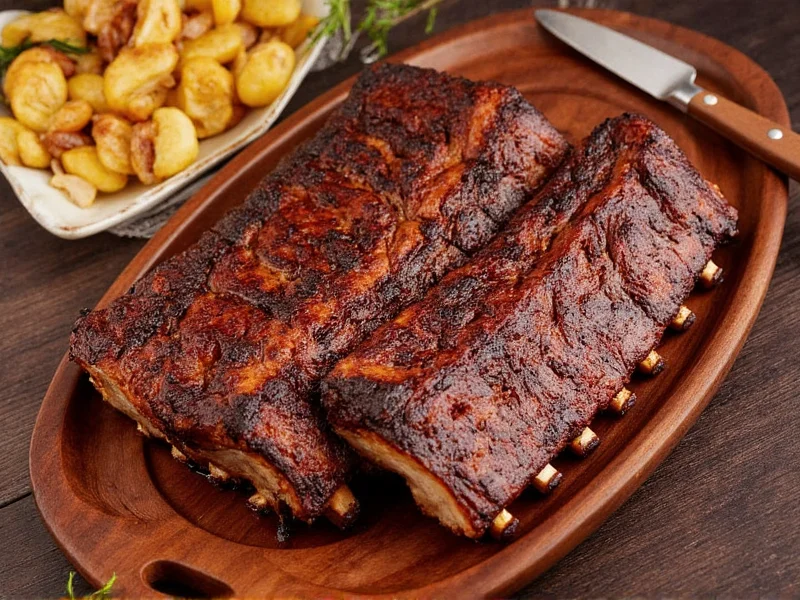When you're browsing the meat section or planning a barbecue, understanding rib varieties matters. St. Louis style ribs represent one of the most popular pork rib cuts in American barbecue culture, prized for their uniform shape, balanced meat-to-fat ratio, and excellent grilling properties. Unlike baby back ribs that come from higher on the hog near the spine, St. Louis style ribs are cut from the belly portion of pork spare ribs after removing the sternum bone, rib tips, and excess fat.
What Defines St. Louis Style Ribs
The distinctive St. Louis cut transforms irregular spare ribs into neat, rectangular racks through precise butchering. Butchers remove the hard breastbone and chewy rib tips, creating a consistent shape that cooks evenly on grills and smokers. This standardized cut originated in St. Louis, Missouri, where meatpackers developed it to create a more marketable product from spare ribs.
Pork Ribs vs. Beef Ribs: Clearing the Confusion
Many people wonder are St. Louis style ribs pork or beef because both animals produce rib cuts. However, the term "St. Louis style" applies only to pork. Beef ribs come in different varieties like back ribs or plate ribs, but they're never called St. Louis style. The confusion often stems from:
- General unfamiliarity with meat cutting terminology
- Restaurants occasionally mislabeling menu items
- Regional variations in barbecue traditions
| Rib Type | Animal Source | Characteristics |
|---|---|---|
| St. Louis Style | Pork | Square shape, moderate fat, consistent cooking |
| Baby Back | Pork | Curved, leaner, more expensive |
| Spare Ribs (untrimmed) | Pork | Irregular shape, more bone and fat |
| Beef Back Ribs | Beef | Shorter bones, meat between bones |
The Butchering Process That Creates St. Louis Cut
Professional butchers transform pork spare ribs into St. Louis style through a specific trimming process. First, they remove the sternum bone (breastbone) that runs along the bottom edge. Next, they cut away the rib tips—the chewy, cartilage-heavy section at the bottom. Finally, they trim excess fat and cartilage to create that signature rectangular shape. This careful preparation makes St. Louis ribs ideal for even cooking and attractive presentation.
Why St. Louis Style Ribs Stand Out in Barbecue
Barbecue enthusiasts prefer St. Louis style ribs for several practical reasons. Their uniform thickness ensures consistent cooking without some sections drying out while others remain undercooked. The balanced fat content renders beautifully during slow smoking, basting the meat internally while creating that desirable bark on the exterior. Compared to baby backs, they offer more meat per bone and develop richer flavor from the marbling. Many competition pitmasters choose St. Louis cut for its reliability and crowd-pleasing qualities.
Cooking Tips for Perfect St. Louis Style Ribs
When preparing St. Louis style pork ribs, remember they benefit from the "low and slow" approach. Plan for 5-6 hours at 225°F for optimal tenderness. Many pitmasters recommend the 3-2-1 method: three hours unwrapped, two hours wrapped in foil with liquid, and one hour unwrapped to set the sauce. The rectangular shape makes them ideal for clean slicing between bones after cooking. Always look for ribs with even meat coverage and minimal trimming when selecting your rack.
Addressing Common Misconceptions
Despite clear industry standards, confusion persists about what meat St. Louis style ribs are made from. Some restaurants might incorrectly label beef ribs as St. Louis style, while others might serve trimmed beef short ribs and use similar terminology. Authentic St. Louis cut, however, has always referred specifically to trimmed pork spare ribs. The USDA recognizes St. Louis style as a pork rib preparation method, not a beef product. When shopping, check packaging labels carefully—reputable butchers and grocery stores will specify "pork" when referring to St. Louis style ribs.
Are St. Louis style ribs the same as spare ribs?
No, St. Louis style ribs are a specific cut made from pork spare ribs. Butchers trim spare ribs to create St. Louis style by removing the sternum bone, rib tips, and excess fat, resulting in a more uniform rectangular shape.
Why do some people think St. Louis ribs are beef?
The confusion arises because both pork and beef have rib cuts, and some restaurants or retailers might mislabel products. However, St. Louis style specifically refers to a pork rib preparation method developed in St. Louis, Missouri.
How can I tell if ribs are authentic St. Louis style?
Authentic St. Louis style ribs should be rectangular with uniform bone length, come from pork (check packaging), and lack the rib tips and sternum bone found on untrimmed spare ribs. The meat should show consistent marbling throughout the rack.
Which is better: St. Louis style or baby back ribs?
This depends on preference. St. Louis style ribs have more fat and connective tissue, creating richer flavor when slow-cooked. Baby backs are leaner, more expensive, and cook faster. St. Louis cuts offer more meat per bone and are generally considered better for traditional barbecue smoking.
Can I substitute beef ribs for St. Louis style in recipes?
No, because St. Louis style specifically refers to a pork rib cut. Beef ribs have different cooking times, fat content, and flavor profiles. If a recipe calls for St. Louis style ribs, it expects pork ribs prepared in that specific trimmed style.











 浙公网安备
33010002000092号
浙公网安备
33010002000092号 浙B2-20120091-4
浙B2-20120091-4